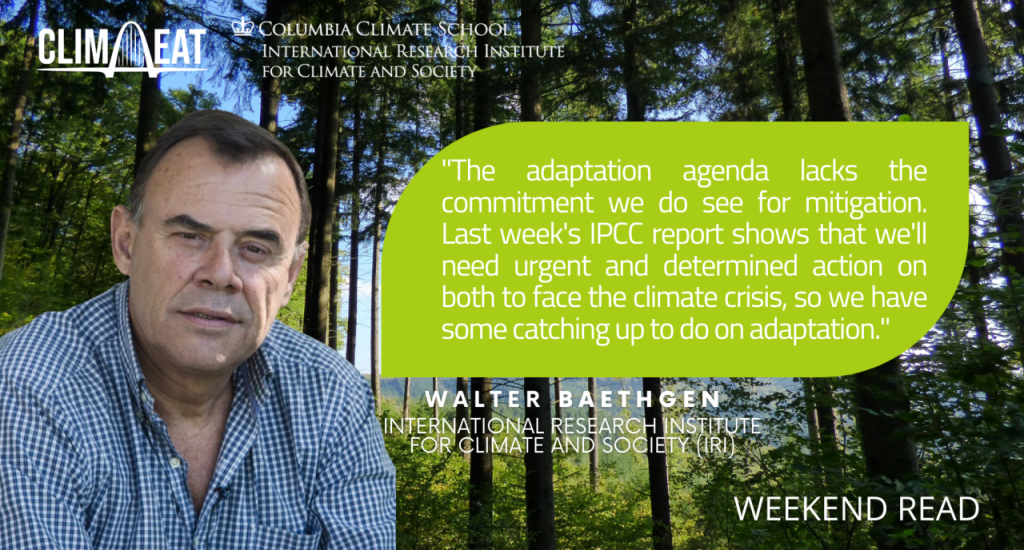Catching up on adaptation: Why are adaptation commitments lagging compared to mitigation?
This post originally appeared on Clim-Eat’s LinkedIn Page as a part of their Weekend Read Series.

Right before COP26, the IPCC published its Working Group I report: The Physical Science Basis of Climate Change (AR6-WGI, 2021). One of its key messages is that it is indisputable that human activities are causing climate change, which is increasing the frequency and severity of extreme climate events around the world. The report states that “there is no going back from some changes in the climate system. However, some changes could be slowed and others could be stopped by limiting warming.” This means that both mitigation and adaptation will be crucial in this climate crisis.
Around the same time the Global Methane Assessment (2021) was published. It highlighted reducing methane emissions as an effective way to reduce global warming immediately. Methane, a greenhouse gas with high warming potential, remains in the atmosphere about 10-15 years (compared to +1,000 years of CO2) and therefore, reducing its emissions will have an immediate impact on global warming.
There is a generalized idea that mitigation efforts will benefit the entire planet, while improved adaptation would only help individual countries. We need to rethink this framing. Improved adaptation will result in fewer famines, reduced migration, less conflict, and more stable political conditions. These are benefits that reach far beyond country borders.
Walter Baethgen, IRI
There are readily available measures that can reduce methane emissions by 30% in 2030. About half of those measures can be achieved with technologies that are already available in the fossil fuel sector at relatively low cost, or even generating profits. There are also effective technologies to reduce methane emissions in the waste and agricultural sectors.
Following the report, one of the outcomes of COP26 was the Global Methane Pledge in which 105 countries committed to reduce their overall methane emissions by 30% by 2030. The pledge was a significant mitigation commitment by a large number of countries, informed by scientific insights about both the problem and concrete measures to reduce it.
This effective exchange between science and policy is something we’ve seen more often around climate mitigation in the last 25 years. For example, the need and our ability to move away from fossil fuels and towards renewable energy sources heavily depended on science and innovations. Today, the cost of solar energy is 400 times lower than in the 1970s.
The process of science informing decisions, policy and investments for improved adaptation has been quite different. For decades the scientific community has produced evidence of the burden of a changing climate on food production, public health, and natural ecosystems, which was echoed in last week’s IPCC Working Group II latest report on the impacts, adaptation and vulnerabilities related to climate change.
The report includes strong evidence of the huge impacts that extreme events are having on agriculture, natural ecosystems, cities, public health, and society in general. Again, the IPCC warns for the danger of inaction. The irreversibility of some effects and weak adaptation will result in huge economic, ecological and human losses. This will be especially true for low- and middle-income countries where various social and economic factors contribute to increased vulnerability and low resilience.
Opposed to the commitment on mitigations, illustrated by the Global Methane Pledge, actions on adaptation are disappointing. Indeed, at COP26 there was a pledge of developed countries to reach a total contribution of US$100 billion per year on climate funding as soon as possible. The countries could “consider doubling adaptation finance”, a formulation that is only a watered-down version of what some Parties wanted. The text of the Glasgow COP26 agreement “urges”, as opposed to requests, these countries to double adaptation finance from 2019-2025. About 75% of the expected funding will get to developing countries in the form of loans and not as grants.
In general, the adaptation agenda lacks the commitment we do see around mitigation initiatives. Why are these reactions to deal with adaptation so different from those focusing on mitigation? My thoughts:
- Firstly, for too long the efforts on adaptation have been focused on climate change scenarios that are too far in the future (2080-2100). Developing countries have urgent needs that cannot be addressed by policies and actions based on scenarios for 2050 or later. The emphasis on the impact of global warming on extreme events found in the latest IPCC reports should help us focus on concrete and urgent actions to reduce vulnerability and increase resilience.
- Second, the best tools for determining future climate scenarios provide information at a scale that is too coarse and uncertain to effectively inform national and local decisions. Unfortunately downscaling those scenarios does not help; it presents well known scientific impediments and we would be zooming-in to the same uncertainty (read more about this).
- Finally, there is a generalized idea that mitigation efforts will benefit the entire planet, while improved adaptation would only help individual countries. We need to rethink this framing. Improved adaptation will result in fewer famines, reduced migration, less conflict, and more stable political conditions. These are benefits that reach far beyond country borders.
By focusing on urgent adaptation needs and opportunities, and explicitly connecting adaptation with development efforts, we can move beyond these obstacles and realize more effective adaptation recommendations, policies and investments. That way we can reshape the adaptation agenda to be more action-oriented and push for commitments that match the level of commitment we’ve seen on mitigation. There is clearly some catching up to do on adaptation ambitions, and COP27 in Egypt will be the place to do exactly that, so we can focus on implementing the past years’ commitments on both mitigation and adaptation.

You must be logged in to post a comment.